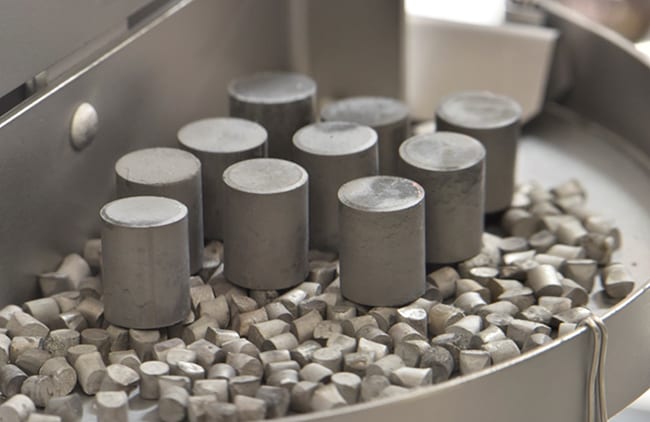Exelon’s Byron 2 Completes First Insertion of Westinghouse Accident-Tolerant Fuel
The post Exelon's Byron 2 Completes First Insertion of Westinghouse Accident-Tolerant Fuel appeared first on POWER Magazine.
Exelon's Byron Unit 2 nuclear power plant has completed installation of EnCore Fuel, Westinghouse Electric Co.'s accident-tolerant fuel (ATF) solution, marking the start of the first test of uranium silicide fuel pellets in a commercial nuclear reactor.
The installation, completed during the plant's scheduled 18-day spring refueling outage this April, but publicly announced on Sept. 5, marks a major milestone for Westinghouse's development of the new fuel, which is part of the Department of Energy's (DOE) Accident Tolerant Fuel Program, an industry-led effort to deliver the new family of robust fuels to market by 2026.
ATF is an industry concept used to describe new technologies-in the form of new cladding and/or fuel pellet designs-that further enhance the safety and performance of nuclear materials. While ATF technologies have been under development since the early 2000s, they have received a marked boost in the wake of the Fukushima accident in March 2011 as the DOE aggressively implemented plans under its congressionally mandated EATF program to develop ATFs for existing light water reactors. The program today casts a wide net of collaboration that includes several U.S. utilities, universities, and the Electric Power Research Institute, and under it, two vendors have already installed ATF concepts at two U.S. reactors.
A First for Uranium Silicide PelletsThe Byron 2 installation involved insertion of two lead test assemblies that contain chromium-coated zirconium cladding for enhanced oxidation and corrosion resistance, higher density ADOPT pellets-which is a chromia (Cr2O3) and alumina (Al2O3) doped UO2 pellet-for improved fuel economics, and uranium silicide pellets, Westinghouse said on Sept. 5.
According to Westinghouse, EnCore Fuel has the "game-changing" potential to significantly increase public safety through revolutionary new materials, while at the same time improving the economics of plant operation through longer fuel cycles and enhanced flexible power operation capability.
Westinghouse's, which is seeking a grant totaling more than $93 million from the DOE to develop EnCore Fuel, plans to deploy the new fuel to market in two phases.

Anticipated EnCore Fuel Program Timeline. Courtesy: Westinghouse
Testing of the chromium-coated zirconium coated-cladding fuel rods loaded with ADOPT pellets at Byron 2 will run until 2022. The combination of the advanced rod coating along with ADOPT pellets "can provide utilities with increased pellet uranium loading, improved fuel utilization, increased loss-of-coolant accident (LOCA) margins, enhanced debris fretting resistance and higher burnup," Westinghouse said.
The coated cladding essentially works to reduce oxidation and hydrogen pickup achieved during normal operation (250C to 350C) and is designed to prolong cladding life. It also supports extended exposure to high temperature steam and air (1,300C to 1,400C), which may occur during a loss-of-coolant accident, a reactivity-initiated accident, and beyond-design-bases conditions. The ADOPT pellet, which Westinghouse has manufactured for more than two decades, and already delivered in 2,700 fuel assemblies, is designed to achieve greater uranium efficiency.
Perhaps more significantly, for the first time, the Byron project will also test uranium silicide pellets, which are more advanced fuel pellet designs. "These designs allow significantly more uranium to be packed into the same volume than current UO2. Uranium silicide's increased thermal conductivity provides safety improvements by reducing the amount of stored energy while allowing a much higher linear heat rate, or burnup, before it melts," Westinghouse said.
The second phase of the EnCore Fuel program will feature silicon-carbide (SiC) cladding and advanced fuel pellets, intended to offer significant safety benefits in beyond-design-basis accident scenarios. This is "enabled by SiC's extremely high melting point and the high thermal conductivity of the advanced fuels," Westinghouse said. SiC cladding reacts 10,000 times slower with water and steam than zirconium at 1200C, resulting in minimal generation of heat and hydrogen in beyond-design-basis accident scenarios, it explained.
Third of a Kind with Equal Importance to ATF DevelopmentEnCore Fuel test fuel rods manufactured in 2018 and 2019 have undergone exposure in the Advanced Test Reactor (ATR) and Transient Reactor Test Facility (TREAT) reactors at Idaho National Laboratory, as well as other test reactors to develop data required for licensing by the the Nuclear Regulatory Commission (NRC), which is still finalizing guidance. The NRC told Congress this March that it is engaging with industry to understand ATF progress, and it will review topical ATF reports through 2020, but it will issue generic guidance on regulatory requirements associated with lead test assemblies in mid-2019.

Westinghouse worked with Idaho National Laboratory to develop the silicide pellets, which were manufactured at the lab. The pellets are enclosed in a zirconium alloy cladding. Source: INL
Along with Westinghouse, Framatome, and GE's Global Nuclear Fuel (GNF) are also developing ATF concepts under the DOE's program. The DOE on Sept. 10 told POWER that all three vendors "are roughly two years ahead of schedule in terms of testing their fuels in commercial reactors."
GNF in March 2018 installed iron-chromium-aluminum fuel cladding material known as "IronClad" and coated zirconium fuel cladding known as "ARMOR" at Southern Co.'s Edwin I. Hatch Nuclear Plant near Baxley in southeastern Georgia. And on April 3, 2019, as Bryon 2 was preparing to enter its outage to install the EnCore assemblies, Framatome completed installation of four GAIA lead fuel assemblies containing enhanced ATF (EATF) pellets and cladding at Southern Co.'s Alvin W. Vogtle Electric Generating Plant's Unit 2 in Georgia. Over the next year, GNF is also expected to begin testing of the IronClad and ARMOR concept at Exelon's Clinton nuclear plant in Illinois.
-Sonal Patelis a POWER senior associate editor (@sonalcpatel, @POWERmagazine).
The post Exelon's Byron 2 Completes First Insertion of Westinghouse Accident-Tolerant Fuel appeared first on POWER Magazine.